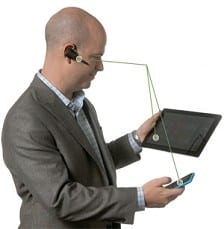How we communicate
Businesses are adjusting to different communication methods

Brian Donaldson might have to change his career path if he ever feels restricted in his use of technology to communicate with co-workers.
Transitioning from a “traditional” office environment to Microsoft Corp. three years ago was easy, he says. By nature of the company’s work environment, Donaldson, a technology strategist, now regularly uses instant messaging, a hands-free headset for his telephone, a lightweight laptop, a slate computer device on-the-go and a 360-degree noise-activated Polycom camera for conference calls.
His face lights up when he talks about the cool things Microsoft does to promote a mobile and flexible work environment, and he raves about the ability for employees to easily and quickly communicate with one another.
He’s used to the technology, and if he had to give it up, “I don’t think I could do it anymore,” he said. “If that ever happens, I’ll take a job teaching skiing in Colorado or something.”
Communication media have evolved from telephone to email and increasingly to instant messaging and even social media. Businesses have had to adjust to figure out the most effective way to handle different methods.
The Business Record caught up with Donaldson, representatives from Meredith Corp. and Principal Financial Group Inc. and an Iowa State University researcher to discuss the advantages and challenges of using new forms of technology to communicate with co-workers.
Instant messaging
All three companies use instant messaging in some way. It serves as an easy way to ask a quick question and get a quick answer without clogging up someone’s email inbox, Donaldson said.
“If you get 100 emails a day, how much time are you spending just on that administrative task of looking through your inbox?” he said. “Instant messaging seems like such a basic thing, but it’s so impactful to the way we work every day.”
Anthony Townsend, associate professor of information systems at Iowa State, has done research on information technology and how it changes the workplace. Recently, he has been doing research for a company that uses chat rooms – online forums where people can type instant messages to a large group – to do 90 percent of their virtual teamwork activities.
He calls it a very structured, “wonderfully effective medium,” and notes that it also gives employees the opportunity to search back through the conversation for answers or ideas that otherwise might be forgotten.
“It’s actually more productivity enhancing than traditional phone conversations or face-to-face meetings,” Townsend said.
Too informal?
Because people are increasingly used to using instant messaging, personal email and social media communication, Townsend worries that the informal nature of communication between family and friends is translating to work interactions. In the same way people communicate differently when they’re playing pickup basketball versus when they’re working in an office, there needs to be boundaries of professional interaction in digital communication.
“Most of us learn to translate that pretty well in face-to-face communications, but when we get into these media, I think it’s a little difficult to shed the dominant culture of how we use these media, and it then creates problems with communication in the workplace,” Townsend said.
Meredith Corp. Executive Vice President Doug Olson admits that “it’s really easy to hide behind the technology.” He estimates that 99 percent of the time, employees have no issues with communication, but there are rare instances when people need to log off their email account and resolve an issue in person.
“I think it’s pretty easy through tone and unintended consequences for something that somebody doesn’t mean to say to become a bigger issue,” Olson said.
What to use, when
Microsoft, Meredith and Principal have all avoided putting any kind of policy in place as to how people should communicate.
Donaldson worries that people would feel restricted with too much regulation.
Similarly, said Eva Quinn, vice president of corporate relations at Principal. “I think it’s more common sense.” Principal will, though, send employees tips on how to best get a point across through email, for example. “We encourage people to think about ‘what are you trying to accomplish with your communication?’” Quinn said.
Townsend said he thinks people do sometimes struggle with figuring out whether a meeting, phone call, email or instant message is the best way to communicate in a given situation, and that companies should recognize that.
“The best thing to do if you are new in a company is just find out what other people do in that kind of a situation,” he said. “I think there should be guidelines on what are appropriate places for certain types of communication.”
Iowa State set a policy within the last three years that email is the official method of communication for university administration to send notifications to faculty, Townsend said. “Once you decide that, it’s clear how I’m supposed to contact people and how I’m supposed to move through the administrative status of the structure of the university,” he said.
Connecting over distance
A major advantage of technologically advanced communication media is the ability to easily connect with employees in other cities.
Meredith has installed high-definition video conference equipment in its Des Moines and New York locations. The ability to communicate in a face-to-face format without having to travel saves the company money and individual employees from the wear and tear caused by traveling. “You can make it look like you are sitting right across the table from somebody,” Olson said.
Meredith is even using personal video conference devices, or what Olson refers to as
“Skype on steroids.” The company has only five or six of the devices currently, and they are used primarily by high-level executives.
Principal has leadership meetings that connect 15 to 20 locations around the globe, Quinn said. The company also connects with employees en masse through a company service called “Hot News,” which alerts employees immediately to things they need to know. For example, it was recently used to let employees companywide know that everyone was accounted for following an earthquake in Mexico City in March.
At Microsoft, the company’s use of technology is designed to make the office completely mobile. Employees use the Des Moines location at 1408 Locust St. as a landing spot. The company promotes an on-the-go environment by providing employees with a lightweight Samsung laptop computer and corresponding slate device that has all of the same functions. Employees also correspond through video communication on their laptops.
The future
Townsend foresees a blending of people’s personal and professional lives based on the rampant use of technology in communication. That is helped along by the prevalence of communication on social media such as Facebook, and the emphasis on synergy and connectivity in the workplace.
Donaldson said that is something his team deals with at Microsoft. There are times when employees will send each other instant messages after hours, but for the most part they try to respect personal time, he said. There’s even a feature on the Microsoft Outlook email client that allows messages sent at night to not show up until the next morning.
Technologically based communication will only continue to grow, Olson said, and will likely result in more collaboration of different tools. There are already services that allow voice mails to be transcribed to a person’s email inbox.
“I think other collaboration tools will also be put together in a way that they’re able to have one source of all your communication instead of having to check a couple different places,” Olson said.
Important to think about, adds Quinn from Principal, is that as more and more communication options become available, sorting out the vast amount of information coming at you will be challenging.
“I think increasingly in the future, that’s what we’re going to have to do for our employees and customers, is help sort all this stuff out, and make sure we’re delivering what they need, when they need it and how they need it,” she said.











